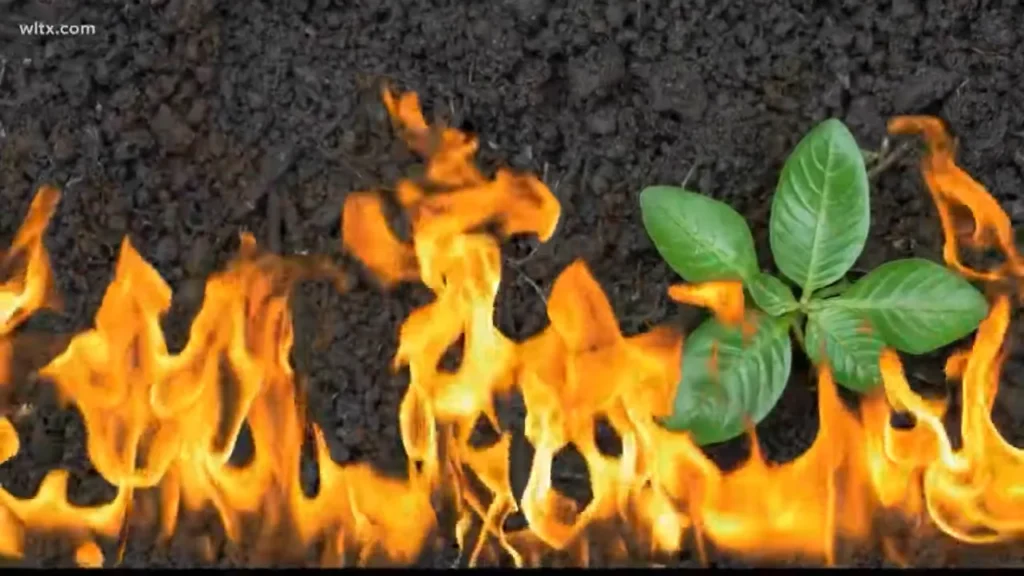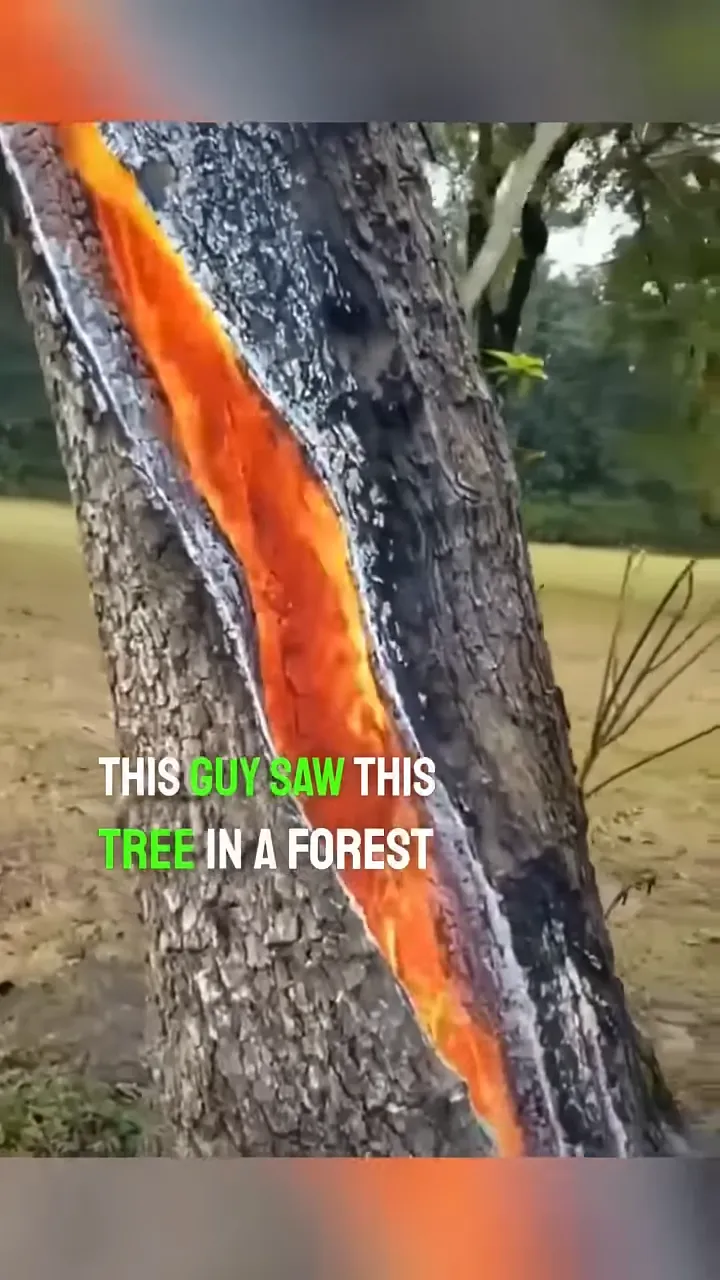Trees, majestic and enduring, are typically seen as resilient symbols of nature’s strength. Yet, the idea of a tree catching fire spontaneously conjures a mix of curiosity and concern. This phenomenon, while relatively rare, raises important questions about the interactions between nature and the elements that may lead to such occurrences.
Spontaneous combustion in trees is not a myth; it’s a rare but real occurrence. Several factors, such as internal decay, fungal infections, and specific environmental conditions, can set the stage for a tree to ignite without an external flame source. The chemistry of the tree itself, combined with the right atmospheric conditions, can create a perfect storm for self-ignition.
Understanding the mechanics behind this natural yet unusual event is not just about satisfying curiosity. It’s crucial for effective forest management, wildfire prevention, and environmental conservation. As we explore this topic, we uncover the intricate balance within nature and the delicate interplay between various natural elements that can lead to such surprising outcomes.
### Importance of Understanding Spontaneous Combustion in Nature
The concept of spontaneous combustion, particularly in the context of nature and trees, presents a fascinating yet complex phenomenon. It’s a subject that intertwines chemistry, physics, and environmental science, offering profound insights into the less-understood aspects of our natural world. Grasping the essence of spontaneous combustion in trees is not only intellectually rewarding but also crucial for effective environmental management and wildfire prevention strategies.
### The Science of Spontaneous Combustion
#### Definition and Basic Principles
Spontaneous combustion, at its core, refers to the occurrence of a fire starting without an external ignition source, such as a spark or flame. This process involves a material heating up through an internal chemical or biological reaction until it reaches its ignition point. In the context of trees, this phenomenon is influenced by a combination of factors, including the chemical makeup of the tree, environmental conditions, and biological processes.
#### Historical Examples in Nature
History is replete with instances where spontaneous combustion has been theorized or observed in nature. Reports of haystacks, coal heaps, and even compost piles igniting spontaneously have been documented for centuries. These occurrences, although not always conclusively proven, provide a historical backdrop to the understanding of spontaneous combustion in a natural context.
### Factors Influencing Spontaneous Combustion in Trees
#### Types of Trees More Susceptible
Not all trees are equally susceptible to spontaneous combustion. Species rich in oils and resins, such as pine and eucalyptus, are more prone to this phenomenon. These natural substances can undergo oxidation or other chemical reactions, generating heat over time.
#### Environmental Conditions That Increase Risk
The environment plays a pivotal role in influencing the likelihood of spontaneous combustion in trees. Factors such as temperature, humidity, and the presence of other combustible materials can significantly alter the risk.
##### Climatic Factors
###### Role of Temperature and Humidity
Temperature and humidity directly affect the rate at which chemical reactions occur within a tree. High temperatures can accelerate these reactions, while humidity levels can either aid or hinder the process. Low humidity, for example, can dry out the tree, making it more susceptible to combustion.
###### Impact of Drought Conditions
Drought conditions exacerbate the risk of spontaneous combustion in trees. Prolonged dry spells lead to dehydration, stressing the trees and making them more prone to internal chemical reactions that could lead to ignition.
##### Biological Factors
###### Internal Decay and Fungal Infection
Trees undergoing internal decay or suffering from fungal infections are more at risk. These processes can change the chemical composition of the wood, creating conditions conducive to heat generation and potential ignition.
###### Chemical Composition of Trees
The chemical makeup of a tree is a critical factor in its susceptibility to spontaneous combustion. The presence of certain chemicals, such as oils and resins, can create a volatile internal environment that increases the likelihood of self-ignition.
### Case Studies: Spontaneous Combustion in Forests
#### Documented Instances Around the World
There have been notable cases around the globe where spontaneous combustion is suspected to have caused forest fires. These instances provide valuable data and insights into the phenomenon, allowing scientists to study and understand the conditions that lead to such events.
#### Analysis of Contributing Factors
Each documented case of spontaneous combustion in forests is a puzzle piece in understanding this complex phenomenon. By analyzing these instances, researchers can identify common factors, such as specific tree species, climatic conditions, and environmental stresses, that contribute to the likelihood of spontaneous combustion.
### The Role of Human Activity

Human activity, often overlooked, plays a significant role in the increased risk of tree fires, including those caused by spontaneous combustion. While direct actions like arson are clear contributors, indirect influences are subtler yet impactful.
#### Indirect Contributions to Increased Risk
The indirect contributions of human activities to the risk of tree fires are multifaceted. Urban development, for instance, alters natural landscapes, impacting the microclimate around forests and increasing the likelihood of conditions conducive to tree fires. Pollution, another significant factor, affects the chemical composition of the soil and air, which can, in turn, influence the health and combustibility of trees.
#### Prevention Strategies in Forest Management
Effective forest management strategies are essential to mitigate the risk of tree fires, both spontaneous and otherwise. These strategies include:
– **Regular Monitoring:** Keeping a close watch on forest health and environmental conditions to identify potential risks early.
– **Controlled Burns:** Intentionally setting small, controlled fires to reduce the amount of combustible material in the forest.
– **Reforestation:** Planting trees and vegetation strategically to create a healthier and more resilient forest ecosystem.
– **Education and Outreach:** Informing and engaging the public about their role in preventing forest fires.
### Debunking Myths: What Doesn’t Cause Tree Fires
Several myths and misconceptions surround the causes of tree fires. It’s crucial to address these to foster a better understanding of the real risks and preventive measures.
#### Common Misconceptions and Their Origins
Myths about tree fires often arise from a lack of understanding of forest ecology and the science behind fire. For example, a common myth is that a tree can catch fire simply from extreme heat or sunlight. While high temperatures can contribute to the conditions for a fire, they alone do not cause a tree to spontaneously combust.
#### Scientific Explanations to Counter Myths
Scientific explanations offer clarity and debunk these myths. For instance, while extreme heat can be a factor, it must be coupled with other conditions like dryness, decay, or chemical reactions within the tree for a fire to start. Educating the public on these scientific principles is vital in dispelling myths and promoting accurate knowledge.
### Safety Measures and Prevention
Prevention of tree fires, spontaneous or otherwise, requires a combination of strategies involving both forest management and public awareness.
#### Guidelines for Forest Visitors
Visitors to forests and natural areas can play a crucial role in preventing fires. Some key guidelines include:
– **No Open Flames:** Avoid using open flames, such as campfires or candles, especially in dry conditions.
– **Dispose of Waste Properly:** Litter, especially glass or plastic, can magnify the sun’s rays and potentially start a fire.
– **Stay Informed:** Pay attention to forest fire warnings and adhere to any restrictions in place.
#### Measures for Forest Management and Firefighting

On the management side, proactive and reactive measures are both essential. Proactive measures include maintaining forest health and implementing early warning systems. Reactive measures focus on effective firefighting techniques and rapid response strategies to minimize damage when a fire does occur.
In conclusion, understanding the role of human activity in forest fires, debunking common myths, and implementing robust safety and prevention measures are key to reducing the risk of tree fires. Through a combination of informed forest management and public awareness, we can better protect our forests and their ecosystems.
### Monitoring and Technology
The advancement of technology has revolutionized the way we monitor and manage forest health and fire risks. Today, a range of advanced techniques and tools are employed in forest surveillance, dramatically enhancing our ability to detect and prevent fires, including those that could arise from spontaneous combustion in trees.
#### Advanced Techniques in Forest Surveillance
Forest surveillance has evolved from ground patrols to sophisticated systems that leverage technology for comprehensive monitoring. Key advancements include:
– **Satellite Imaging:** Utilizing satellites equipped with high-resolution cameras and thermal sensors to monitor large forest areas. These systems can detect changes in vegetation, soil moisture levels, and signs of potential fire risks from space.
– **Drones:** Drones equipped with cameras and sensors provide a bird’s-eye view of forest conditions. They can access remote or dangerous areas, offering real-time data on forest health and potential fire hazards.
– **Sensor Networks:** Deploying networks of sensors throughout forests to monitor environmental conditions like temperature, humidity, and wind speed. These sensors provide valuable data that can predict and detect early signs of fire.
#### Use of Technology in Early Detection and Prevention
Technology plays a pivotal role in the early detection and prevention of forest fires. Some of the key technologies include:
– **Predictive Analytics:** Using data from various sources, including satellite imagery and sensor networks, predictive analytics tools can forecast high-risk areas and periods for forest fires.
– **Artificial Intelligence (AI):** AI algorithms analyze vast amounts of data to identify patterns and anomalies indicative of fire risks, allowing for quicker and more accurate predictions.
– **Mobile Applications:** Apps that provide real-time information to forest managers and the public about fire risks and incidents. These apps can also be used to alert people in the vicinity of a fire.
### The Future of Forest Fire Management
As we look to the future, forest fire management is poised to become more sophisticated, with research and technology continuing to evolve.
#### Emerging Research and Trends
Emerging research in forest fire management focuses on enhancing our understanding of fire ecology and developing more effective prevention and control strategies. Key trends include:
– **Climate-Adaptive Strategies:** Developing forest management practices that are adaptable to the changing climate, ensuring resilience against increased fire risks.
– **Integrated Fire Management:** Combining traditional knowledge with modern science to create holistic fire management strategies that consider ecological, social, and economic factors.
– **Enhanced Material Science:** Research into new materials and technologies for firefighting equipment, making it more effective and safer for firefighters.
#### Potential Impact of Climate Change
Climate change poses a significant challenge to forest fire management. Increased temperatures, altered precipitation patterns, and more frequent extreme weather events contribute to higher fire risks. Managing these evolving risks requires adaptive strategies, informed by ongoing research and climate modeling.
### Recap of Key Insights
Reflecting on the key insights from our exploration of spontaneous combustion in trees and forest fire management, several themes emerge:
– **Complex Interplay of Factors:** Tree fires, including those caused by spontaneous combustion, result from a complex interplay of biological, environmental, and human factors.
– **Importance of Technology:** Advanced technology and monitoring systems play a crucial role in early detection and prevention of forest fires.
– **Evolving Strategies:** As our understanding of fire ecology deepens and as climate change alters the landscape, forest fire management strategies must evolve to stay effective.
### Importance of Awareness and Preventive Measures in Forest Fire Management
Awareness and preventive measures are critical components of forest fire management. Educating the public about fire risks and prevention, coupled with effective forest management practices, can significantly reduce the incidence and impact of forest fires. This includes understanding the phenomena like spontaneous combustion and being vigilant about the various factors that contribute to forest fires. As we advance in technology and knowledge, our collective responsibility to protect our forests and natural resources becomes ever more vital, ensuring a safer and healthier environment for all.
How do you tell if a tree was in a fire?
Determining if a tree has been in a fire involves looking for several key indicators. These signs can vary depending on the severity of the fire and the type of tree, but generally include:
1. **Charring and Soot Deposits**: The most obvious sign is charring on the bark. Trees that have been exposed to fire often have blackened, charred areas on their trunks. Soot deposits can also be present on the bark and in the surrounding area.
2. **Damaged or Missing Bark**: Fire can cause the bark to crack, peel, or even slough off completely in some areas. This damage can leave parts of the trunk exposed and more susceptible to pests and disease.
3. **Scorched Leaves and Needles**: In cases where a fire has not been intense enough to completely consume foliage, leaves or needles may appear browned, dried out, or scorched at the tips.
4. **Crown Damage**: The canopy or crown of the tree may show signs of fire damage, such as dead or missing branches, blackened leaves, or a completely scorched appearance.
5. **New Growth Patterns**: After a fire, some trees may exhibit unusual growth patterns as they attempt to recover. This can include abundant sprouting from the base of the trunk or along branches where foliage was lost.
6. **Changes in Coloration**: Apart from charring, the color of the bark might change due to heat exposure. It may appear darker or have a different texture compared to unaffected areas.
7. **Bud and Flower Damage**: Flowers and buds may be burnt or absent in the season following a fire, as the tree may have diverted energy to survival and recovery rather than reproduction.
8. **Health Decline**: In the months or even years following a fire, a tree may show signs of declining health, such as reduced foliage, stunted growth, or increased susceptibility to disease and pests.
It’s important to note that some trees have remarkable resilience to fire and can recover, while others may be more severely affected and eventually die. Assessing a tree’s health after a fire often requires expertise, especially when considering long-term impacts and recovery potential.
### Frequently Asked Questions
#### Can Lightning Cause Trees to Spontaneously Combust?
While lightning doesn’t cause spontaneous combustion, it can ignite a tree. Spontaneous combustion refers to ignition without an external source like lightning. However, lightning strikes can lead to fires if they provide enough heat to ignite the tree’s materials.
#### Are Certain Types of Trees More Likely to Self-Ignite?
Yes, certain tree types are more susceptible to self-ignition. Trees with high resin content or those undergoing internal decay and fungal infection have a higher risk. Environmental factors like extreme heat and drought also play a significant role.
#### How Can We Prevent Spontaneous Tree Fires?
Preventing spontaneous tree fires involves managing forest health and monitoring environmental conditions. This includes clearing deadwood, controlling diseases and pests, and monitoring drought conditions to reduce the risk of combustion.
#### Does Climate Change Affect the Likelihood of Such Fires?
Climate change, by altering weather patterns and increasing temperatures, can increase the likelihood of conditions favorable for spontaneous combustion. This includes prolonged droughts and heatwaves, making forests more susceptible to fires.
### Conclusion
The phenomenon of trees catching fire by themselves, while rare, holds significant implications for our understanding of nature’s dynamics. It reminds us of the intricate and often unseen interactions that occur within our environment. The knowledge of such occurrences plays a vital role in forest management and wildfire prevention strategies, highlighting the need for continuous research and monitoring.
The balance of nature is delicate, with each element playing a critical role. The phenomenon of spontaneous combustion in trees is a testament to this balance, serving as a reminder of the importance of respecting and understanding our natural world.
As we continue to explore and learn about these rare events, we not only satisfy our curiosity but also equip ourselves with the knowledge necessary to better protect and preserve our natural environments. In doing so, we ensure a healthier and safer world for future generations.



